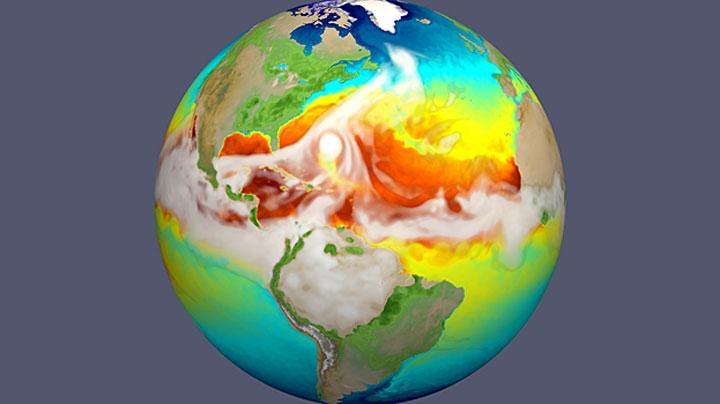Earth System Model (HT)

- 10 Feb 2024
Why is it in the News?
The Indian Institute of Tropical Meteorology is developing a first-for-India Earth System Model to improve climate forecasts and predict climate impacts.
What is an Earth System Model (ESM)?
- An Earth System Model (ESM) is a complex computer program that simulates the interactions between the various components of our planet's climate system, including the atmosphere, oceans, land, ice, and biosphere.
- These models are crucial for understanding past, present, and future climate trends, and are used for purposes like:
- Improving weather forecasts: By accounting for intricate interactions between different parts of the Earth system, ESMs can potentially lead to more accurate weather predictions, particularly for longer-term forecasts.
- Predicting climate change impacts: By simulating different scenarios of greenhouse gas emissions and other influencing factors, ESMs can project how climate change might affect specific regions and aspects like temperature, precipitation, and sea level rise.
- Informing adaptation and mitigation strategies: With insights into potential climate impacts, policymakers and individuals can make informed decisions about adapting to and mitigating the effects of climate change.
India's Earth System Model:
- Recognizing the importance of such models, India is currently developing its first-ever indigenous Earth System Model, led by the Indian Institute of Tropical Meteorology (IITM) and the Centre for Climate Change Research (CCCR).
- An amount of ?192.28 crores has been sanctioned under the Monsoon Convection, Clouds and Climate Change (MC4) sub-scheme to develop the climate forecasting system
- This project, funded by the Ministry of Earth Sciences, aims to:
- Enhance forecast accuracy: The model will incorporate advanced features to improve the reliability of weather forecasts, particularly for monsoons that are crucial for India's agriculture.
- Facilitate long-term climate studies: By simulating various climate scenarios, the model will provide valuable insights into potential future climate changes affecting India.
- Predict climate impacts: This model will help assess the risks and potential impacts of climate change on various sectors like agriculture, water resources, and coastal ecosystems.
- The project is expected to be completed by 2025 and is believed to be a significant step towards improving India's understanding and preparedness for the challenges posed by climate change.
About the Monsoon Convection, Clouds, and Climate Change (MC4) Sub-Scheme:
- The MC4 initiative aims to enhance our understanding of monsoonal precipitation changes and their implications in a warming climate by enhancing observational databases and climate models.
- Its overarching objective is to refine our understanding of the interactions between monsoon dynamics, clouds, aerosols, precipitation, and the water cycle within a changing climate context.
The nodal ministry overseeing this effort is the Ministry of Earth Sciences (MoES).
What is an Earth System Model (ESM)?
- An Earth System Model (ESM) is a complex computer program that simulates the interactions between the various components of our planet's climate system, including the atmosphere, oceans, land, ice, and biosphere.
- These models are crucial for understanding past, present, and future climate trends, and are used for purposes like:
- Improving weather forecasts: By accounting for intricate interactions between different parts of the Earth system, ESMs can potentially lead to more accurate weather predictions, particularly for longer-term forecasts.
- Predicting climate change impacts: By simulating different scenarios of greenhouse gas emissions and other influencing factors, ESMs can project how climate change might affect specific regions and aspects like temperature, precipitation, and sea level rise.
- Informing adaptation and mitigation strategies: With insights into potential climate impacts, policymakers and individuals can make informed decisions about adapting to and mitigating the effects of climate change.
India's Earth System Model:
- Recognizing the importance of such models, India is currently developing its first-ever indigenous Earth System Model, led by the Indian Institute of Tropical Meteorology (IITM) and the Centre for Climate Change Research (CCCR).
- An amount of ?192.28 crores has been sanctioned under the Monsoon Convection, Clouds and Climate Change (MC4) sub-scheme to develop the climate forecasting system
- This project, funded by the Ministry of Earth Sciences, aims to:
- Enhance forecast accuracy: The model will incorporate advanced features to improve the reliability of weather forecasts, particularly for monsoons that are crucial for India's agriculture.
- Facilitate long-term climate studies: By simulating various climate scenarios, the model will provide valuable insights into potential future climate changes affecting India.
- Predict climate impacts: This model will help assess the risks and potential impacts of climate change on various sectors like agriculture, water resources, and coastal ecosystems.
- The project is expected to be completed by 2025 and is believed to be a significant step towards improving India's understanding and preparedness for the challenges posed by climate change.
About the Monsoon Convection, Clouds, and Climate Change (MC4) Sub-Scheme:
The MC4 initiative aims to enhance our understanding of monsoonal precipitation changes and their implications in a warming climate by enhancing observational databases and climate models.
- Its overarching objective is to refine our understanding of the interactions between monsoon dynamics, clouds, aerosols, precipitation, and the water cycle within a changing climate context.
- The nodal ministry overseeing this effort is the Ministry of Earth Sciences (MoES).
